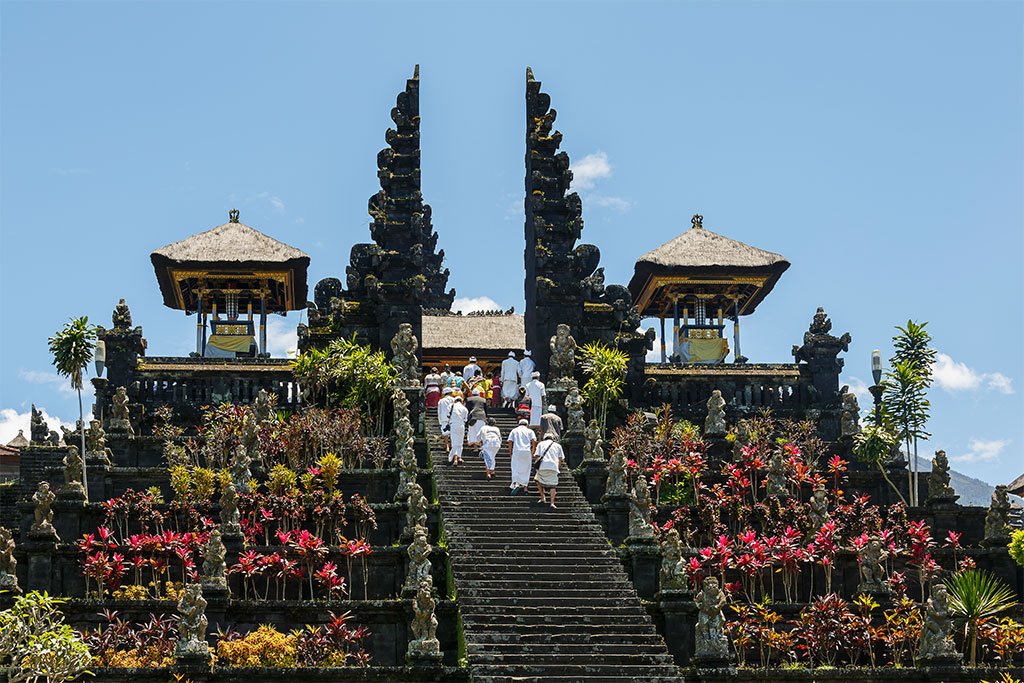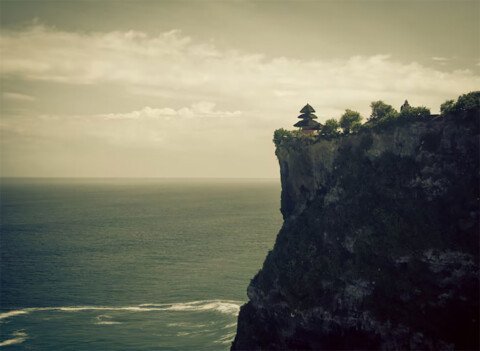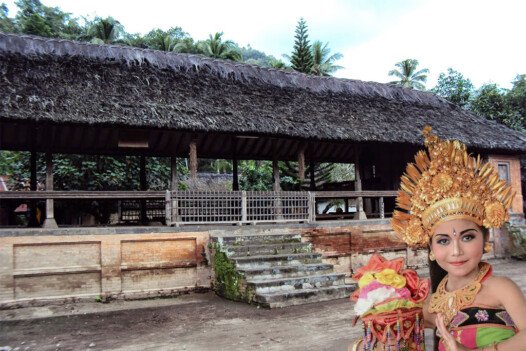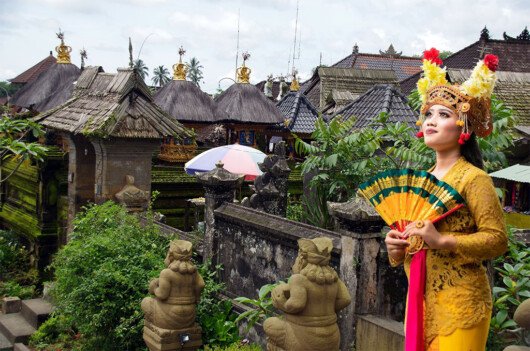There are places in the world where time seems to pause—where the day doesn’t end, it transforms. In Bali, this transformation is most poetic at sunset, and there are three temples where the experience borders on the divine: Uluwatu, Tanah Lot, and Besakih. These aren’t just temples; they are sanctuaries suspended between sky, sea, and soul.
Each one offers a different stage for the sun’s daily descent. Uluwatu stands defiantly on the edge of a cliff, Tanah Lot rises like a dream from the ocean, and Besakih rests solemnly on the volcanic shoulders of Mount Agung. As the light softens and the air cools, these sacred places awaken in new ways—shadows stretch, prayers echo, and colors melt into silence.
Whether you’re a seeker of spirituality, a lover of landscapes, or simply a traveler craving something unforgettable, these temples will not just dazzle your eyes—they will steal your heart. Let the journey begin.
🌅 Sunset – Nature’s Grand Finale
For many travelers, sunset isn’t just a time of day; it’s a spiritual moment, a short-lived masterpiece painted across the heavens. In Bali, sunsets are legendary, and nowhere is this truer than at Uluwatu, Tanah Lot, and Besakih temples. Each temple offers a unique spiritual setting, memorable architecture, and unparalleled ocean or mountain backdrops. Prepare to be captivated.
1. 🌊 Uluwatu Temple: Cliffside Drama & Majestic Culture
1.1 Location & Setting
Perched 70 meters atop limestone cliffs in southwestern Bali, Uluwatu Temple (Pura Luhur Uluwatu) commands views of the Indian Ocean stretching to the horizon. This is drama under the sky — wind-swept hair, crashing waves, and an almost cinematic sense of place.
1.2 Spiritual Experience
Dedicated to Rudra (a manifestation of Shiva), Uluwatu is one of Bali’s six directional temples designed to guard the island. At dusk, the dimming sky and evening ritual (Kecak fire dance) transport you into myth and spirituality.
1.3 The Kecak Fire Dance at Sunset
🔥 The temple stage comes alive just as the sky shifts from gold to indigo. The performance – a troupe of chanting men, a flickering fire, and traditional costumes – is hypnotic. Watching the flames illuminate dancers against the cliff and ocean is pure magic.
1.4 Breathtaking Views and Ambient Energy
Grab a seat along the cliff edge. The panoramic swell of the Indian Ocean, the shrieking of distant fish-eagles, and the rhythmic chants, all sync into a sensory symphony. At sunset, there’s an emotional crescendo – bittersweet, romantic, overwhelming.
1.5 Cultural Intimacy and Respect
Though crowded at times, Uluwatu still feels intimate. Visitors come seeking wonder, not selfies. Temple staff bless visitors with holy water at the entrance, and local guides chaperone tourists to ensure respect for dress codes and rituals. This collective reverence deepens the experience.
2. 🌌 Tanah Lot Temple: Sea Temple Icon & Sunset Mirror
2.1 Dramatic Ocean Embrace
Tanah Lot sits on a rocky islet that gets overtopped by waves at high tide. A causeway appears during low tide—but at dusk, you’ll see it, hear it, feel it: the ceaseless, mesmerizing pulse of the ocean kissing ancient stone.
2.2 Temple of the Sea God
Dedicated to Dewa Baruna (or Varuna), the sea god, Tanah Lot was founded by 16th-century priest Nirartha. It’s a physical prayer to Bali’s maritime roots. The silhouette of the temple against molten skies feels primeval yet timeless.
2.3 The Magical Glow at Sunset
📷 Sunsets at Tanah Lot are postcard-perfect: orange and magenta skies reflected in wet pathways, temple silhouette framed by thrumming waves, crowds hushed in awe—everyone collectively taken by fleeting, flickering beauty.
2.4 Serpents, Caves & Mysteries
Beneath the temple are sea caves believed to be inhabited by sea snakes, guardians of the temple. There’s a hush in the crowds when a snake appears. It’s primal — people step back respectfully, feeling small before ancient beliefs.
2.5 Lively Evening Bazaar
Post-sunset, the area blossoms into a bustling melange of stalls selling handicrafts, snacks, and postcards. It’s a communal celebration: laughter, neon lights, Balinese music—all alive under cooling skies. You absorb culture and community long after dusk fades.
3. ⛰️ Besakih Temple: The Mother Temple on Mount Agung
3.1 Spiritual Heart of Bali
Known as the “Mother Temple,” Pura Besakih sits on the slopes of sacred Mount Agung at 1,000‑1,100 meters elevation. It’s Bali’s holiest complex, composed of over 80 shrines in terraced layout. Here, earth, volcano, sky, and spirit all meet.
3.2 Pre-Dawn to Sunset – A Full-Day Pilgrimage
A visit to Besakih is not a quick stop. It’s a day-long pilgrimage: climbing steps, pausing at shrines, admiring stone gardens, witnessing Hindu priests chanting, sliding offerings into alcoves. By sunset, there’s deep reverence in every breath and view.
3.3 Sunset Over Mount Agung
From the upper terrace, the sun sinks behind jagged ridges and cloud-wrapped peak of Mount Agung. The alkali stone shrines glow amber, the valley lights shimmer below. It’s an immersive moment, where you feel connected with Bali’s spiritual core.
3.4 Rituals and Pilgrims
Visitors may witness melukat (water purification), canang sari (flower offerings), and even weddings. Priests gather to bless pilgrims. The sunset amplifies the solemn beauty — incense clouds thickening, chants echoing between shrines.
3.5 Community & Contemplation
Unlike the bustling Uluwatu and Tanah Lot, Besakih’s vastness invites calm. As temples wind down for the day, local families linger, children chase each other through carved corridors, elders sit in meditation. The quiet fellowship is moving.
4. 🌄 Three Unique Sunset Perspectives
4.1 Ocean Cliffs at Uluwatu
Feel the wind, smell the salt, hear the Pacific’s roar. The ocean feels like a guardian—a living boundary beyond which lies endless possibility.
4.2 Rock and Reflection at Tanah Lot
See temple silhouettes mirrored by shallow puddles, steel-blue water, and polished rock. The interplay of light and shadow plays on the mind’s emotions.
4.3 Mountain Majesty at Besakih
Experience sky-touching formality amid temple spires. The horizon seems higher, the air clearer, the sun setting at a different altitude—power and peace combined.
5. 🧘 Why These Temples Speak to the Soul at Sunset
5.1 Nature and Architecture in Harmony
Each temple is deliberately situated to engage with its environment. Uluwatu on cliffs, Tanah Lot in the sea, Besakih anchored on a volcano slope. Sunset amplifies that bond—light sculpting ancient stones and surrounding nature.
5.2 A Shared Yet Personal Moment
Thousands may visit, yet sunset feels private. The sky dims, thoughts rise. Cameras pause. It’s communal silence, broken only by gasps and whispered prayers.
5.3 Rituals and Reflection
Sunset coincides with prayer, dance, purification, chanting. Rituals feel more potent under soft golden light. If spiritual awakening is possible, it happens then.
5.4 Photographic and Memoir Power
These sunsets become visual poems in your gallery and memory. Golden light etched onto the temple, clouds glowing magenta, silhouettes rippling in reflection—you carry them for life.
5.5 Timeless Cultural Attunement
Bali’s soul is alive at sunset. We feel history and spirit beyond tourist hype. These sunsets aren’t just beautiful—they resonate. They remind us we’re small, fleeting, and connected.
🌟 Expert Tips for an Unforgettable Sunset
⏰ Timing & Planning
- Arrive early—an hour before official sunset—to catch the unfolding drama, find good vantage points, and relax.
- Check the official temple calendar: some days prohibit sunset visits due to Hindu ceremonies.
👔 Dress & Decor
- Standard temple attire: sarong and sash, widely available for rent/sale at Bali’s temple precincts.
- Bring a light outer layer—coastal wind or mountain breeze can be surprisingly brisk.
📷 Photography Tips
- Shoot in JPEG+RAW if you can for maximum post-sunset color control.
- Use a wide-angle lens (16–35 mm) for sweeping horizons or telephoto for intimate silhouette shots.
- Include a foreground object (polished stone, dancers, shrine) to add scale.
☕ Enjoying the Moment
- Buy a cup of warm ginger tea or jaggery coffee (kopi Bali) and let it warm you during watching.
- After, wander the temple grounds—quiet paths, hidden alcoves, small shrines glow in dusk.
🚗 Managed Transport
- Use a driver-guide (1 evening per temple). They’ll know precise sunset time, best angles, parking ease, and entry logistics.
🛤️ Optional Temple-Hopping Sunset Itinerary
- Afternoon – Begin at Besakih, climb terraces, attend a ritual.
- Late Afternoon – Head west to Tanah Lot (1–2 hrs drive). Catch that iconic rock-islet shot.
- Evening – Drive south to Uluwatu (1 hr from Tanah Lot). Attend Kecak Fire Dance at cliffside.
- Night – Optional seafood dinner at Jimbaran Bay, moonlight reflection, live gamelan.
This 12‑hour day paints Bali in mythic colors and leaves visitors transcendent, quiet, luminous.
5 Quick Add‑On Experiences 🌿
- Take a Balinese purification ritual (melukat) at a holy spring near Besakih early in the day—mental clarity to carry into sunset.
- Dine on seafood at Kedonganan Bay after Uluwatu—a cozy, beachside end to the ritual day.
- Attend a full moon ceremony if you’re lucky—temples glow, thousand devotees, chants echoing until sunrise.
- Explore related sites: the Goa Giri Putri cave temple is near, or Goa Lawah (“Bat Cave Temple”) near Candidasa—tweaks add richness.
- Get a drone (if legally permitted) for aerial views at Tanah Lot—temple floating in glow, sea wall around it. Always respect local rules and other visitors.
Emotional Resonance & Cultural Connections
🧠 Memory Impressions
People describe “sunset euphoria,” “soul tears,” “my heart lifts.” Why? Because light polarization, temperature drop, sky colors psychologically tune us to calm, introspection, wonder.
🎭 Spiritual Dialogue
Bali’s temples aren’t museums—they’re living rituals. Sunset ties the cycles of sky with spiritual routine, reminding us life, death, light, dark, energy. A soft, wordless sermon.
👥 Human Threads
You’ll overhear bits of conversation: visitor to guide, “I cried when I saw the silhouette…” Every person brings their story, their tears, and they are all okay.
Final Word
Why will Uluwatu, Tanah Lot, and Besakih temples steal your heart at sunset? Because in these moments, the earth speaks, the ancients whisper, and your soul sings. The wind on the cliff, the waves kissing stone, the silhouettes and chants—they are all invitations: to see your smallness, your longing, your wonder.
No photograph can fully hold this. No words can finish describing it. You have to stand there—waiting, breath held, heart open—to actually receive the gift. And when the sun dips and the sky blooms, Bali blooms inside you, forever.









